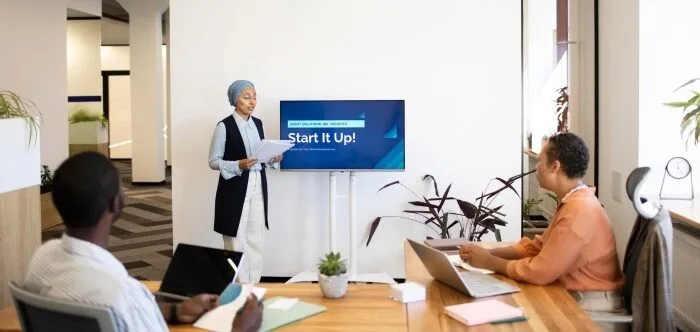Opening slides are the gateway to your conference presentation, offering the first impression that can captivate your audience. A key concern for presenters is understanding what information to list in opening slide for a conference.
To make your slide both informative and engaging, start with the conference title, followed by your name, your professional affiliation, and the title of your presentation. Including the date provides a temporal context, and a succinct overview or agenda sets the stage for what’s to come.
Additionally, incorporating contact information or social media handles can enhance interaction and networking opportunities. Dive deeper into this topic and discover effective strategies by following the rest of our article.
What is a Conference Presentation?
A conference presentation is an opportunity for professionals to share their research, insights, or innovations with a like-minded audience. These presentations often occur in academic, scientific, or industry-specific settings, drawing attendees interested in the topic. They serve as a platform for knowledge exchange, networking, and professional development.
In these sessions, speakers use slides, demonstrations, and speeches to convey their message effectively. The format can vary, ranging from individual talks to panel discussions, depending on the conference’s structure. Each presentation is usually allotted a specific time slot, allowing for a concise yet comprehensive delivery of content.
Encouraging audience engagement is paramount in these presentations, especially when organized by a well-known event planner. Speakers actively foster questions, fostering an interactive atmosphere that enriches the learning journey. This exchange of ideas not only enriches attendees’ experience but also offers invaluable feedback and diverse perspectives to the presenter.
Significance of Opening Slide in a Conference Presentation
A compelling opening slide sets the stage for an engaging and memorable conference presentation. It shapes initial impressions, connects with the audience instantly, and subtly communicates your presentation’s core message. Here’s why the opening slide matters significantly:
Capturing Immediate Attention
An opening slide grabs attention swiftly, drawing attendees away from distractions and towards your presentation in those crucial first moments. Distinct visuals, concise wording, or intriguing questions are effective tools to capture an audience and establish instant relevance effectively. Imagine you’re presenting at a conference in Canada, where dynamic business gatherings abound; you want to stand out among many high-quality presentations. A thoughtful design immediately sparks curiosity, motivating attendees to engage deeply with your subsequent content.
Setting Clear Expectations
Your first slide should transparently communicate your topic, purpose, and direction, eliminating ambiguity about the presentation’s intent and value proposition. Attendees quickly assess whether the content aligns with their professional interests, making clarity indispensable from the outset. The slide acts like a map, guiding listeners through key points efficiently, fostering alignment with your narrative journey ahead. Clearly defining what to expect ensures active and intentional participation from your audience.
Establishing Credibility Early
Establishing credibility early through the opening slide reassures attendees about your authority and expertise. Building initial trust is vital for audience engagement. Highlighting relevant affiliations, credentials, or brief statistics can underscore your expertise subtly, preparing listeners to value your insights deeply. The first impression created here significantly influences audience receptivity to the data or arguments that follow later. Strengthening trust from the start ensures stronger resonance of your core message throughout the session.
Visual Appeal and Professionalism
Professional visual design reinforces your image as a knowledgeable speaker while indicating preparedness and respect for the audience’s valuable time. A thoughtfully designed opening slide reflects dedication and care, communicating professionalism without relying solely on spoken introductions or preliminary comments. Consistent colors, clear fonts, and strategic visuals complement your content, leaving a lasting professional impression. Poor visuals at the outset can unintentionally signal unpreparedness, potentially detracting from your overall presentation impact.
Building Emotional Connection
Engaging your audience emotionally right from the start can significantly enhance the memorability and influence of your presentation’s main points. Emotionally resonant imagery, relatable anecdotes, or strategic questions positioned upfront help create a genuine human connection instantly. When attendees feel personally invested early, they’re more likely to engage actively in complex or technical discussions later. This emotional alignment from the first slide amplifies audience responsiveness and retention of your content.
Facilitating Smooth Transitions
An effectively crafted opening slide helps seamlessly transition attendees into your detailed exploration of ideas, data, or findings presented subsequently. This introductory element can smoothly bridge your general topic overview with more specific, focused insights discussed deeper into your talk. Audience members find structured transitions reassuring, appreciating the clear and logical progression you established upfront. Smoothly connected ideas foster ease in understanding, ensuring clarity and coherence throughout your presentation.
What Information to List in Opening Slide for a Conference?
The perfect opening slide for a conference presentation is both an art and a science. It’s the first thing your audience sees, setting the stage for what follows. A well-structured opening slide can significantly enhance audience engagement and set the right tone. Let’s explore what information to list in opening slide for a conference:
Conference Title
Clearly display the conference name, offering attendees immediate context. This helps in situating your presentation within the broader event. It’s also useful for attendees attending multiple sessions. A prominent conference title aids in recall and association.
Presentation Title
Your presentation’s title should be concise but descriptive. It acts as a headline, grabbing attention and summarizing your topic. Ensure it’s easy to read and understand at a glance. A well-crafted title sets expectations for your talk’s content.
Speaker’s Name and Affiliation
Introduce yourself with your name and affiliation. This builds credibility and helps in connecting with the audience. Include your professional title and ensure that any irrelevant content to the conference presentation is not included, as it may detract from audience engagement. Adding your organization’s logo can also enhance brand recognition.
Date and Time
Listing the date and time provides a temporal reference for the audience. It’s helpful for those attending the session live or watching a recording. This information can also assist in cataloging the presentation for future reference. Including the time zone is crucial for international conferences.
Brief Overview or Agenda
A concise agenda or overview guides the audience through your presentation. It sets expectations about the content and structure. This can also help in keeping your presentation on track. An overview makes the session more accessible and engaging.
Contact Information
Share your email address or professional website for follow-ups. This encourages continued engagement beyond the presentation. It’s a great way to network and connect with interested attendees. Including social media handles can also broaden your professional network.
Visual Elements
Use images or graphics relevant to your presentation’s theme. Visual elements make the slide more engaging and memorable. Ensure these visuals are clear and complement the text. Avoid cluttering the slide with too many graphics.
Acknowledgments or Collaborations
If your work involves collaborators, acknowledge them. This fosters a sense of community and teamwork. Acknowledging funding sources or institutions is also common. This adds a layer of transparency and gratitude to your presentation.
The opening slide is your first opportunity to engage with your audience. By thoughtfully including these elements, you set a professional, informative tone for your presentation, inviting your audience to connect with your content meaningfully.
Things to Consider While Listing in Opening Slide for a Conference
When designing the opening slide for a conference presentation, it’s crucial to consider how each element contributes to your message. This slide is not just an introduction, but a key part of your communication strategy. Making thoughtful choices here can greatly enhance the impact of your presentation.
- Clarity and Conciseness: Ensure the text is clear and concise, making it easy for the audience to grasp key information quickly. Overloading the slide with too much text can overwhelm and confuse viewers.
- Readability: Choose fonts and colors that are easy to read from a distance. Contrasting colors for background and text improve visibility, aiding audience comprehension.
- Branding Consistency: If representing an organization, use its branding elements, like logos and color schemes. This enhances professional appeal and aids in brand recognition.
- Relevance of Visuals: Include relevant images or graphics that complement the presentation’s topic. Irrelevant visuals can distract or mislead the audience, detracting from the message.
- Speaker Identification: Clearly display your name and affiliation, establishing your credibility and authority on the subject. This helps in building a connection with the audience from the outset.
- Agenda Transparency: Briefly outline the main points or agenda of your presentation. This sets clear expectations and helps the audience follow along more effectively.
In crafting your opening slide, remember that simplicity and clarity are key. A well-designed slide not only informs but also engages and sets the stage for a successful presentation.
Essential Steps to Crafting an Effective Opening Slide
An effective opening slide for your conference presentation is a crucial step in engaging your audience. It’s the first point of contact between you and your listeners, setting the tone for your entire talk. Here’s a step-by-step guide to creating an opening slide that captivates and communicates clearly.
Step 1: Define the Presentation’s Purpose
Start by defining the core purpose of your presentation. This will guide the content of your opening slide, ensuring it aligns with your talk’s main objectives. Keep your purpose concise and focused, as it sets the direction for your entire presentation.
Step 2: Choose a Clear, Descriptive Title
Your title should be both clear and descriptive, and enclose the essence of your presentation. It’s the headline of your opening slide and should grab attention while giving an accurate idea of what to expect. Avoid jargon or overly complex language to ensure accessibility.
Step 3: Include Your Name and Affiliation
Introduce yourself with your name and the name of your organization or institution. This establishes your credibility and connects your brand to the presentation. This information should be easily visible and not overshadowed by other elements on the slide.
Step 4: Provide Date and Location Information
Include the date and location of the conference on your slide. This contextual detail is especially important for recordings and helps in situating your presentation within a specific time and place. For virtual events, specifying the time zone is also beneficial.
Step 5: Briefly Outline the Presentation Agenda
A short overview or agenda gives the audience a roadmap of your presentation. This helps in managing expectations and aids in keeping your audience engaged throughout. Keep this outline clear and succinct, highlighting the key points or sections.
Step 6: Incorporate Design Elements Thoughtfully
Use design elements like color, font, and imagery to make your slide visually appealing. Ensure these elements enhance rather than distract from your message. A well-designed slide can make a strong visual impact and aid in audience recall.
Preparing an opening slide is more than just filling in a template; it’s about creating a visual summary of your presentation. A well-executed slide sets the stage for your message, engages your audience, and lays the groundwork for a successful presentation.
Conclusion
The opening slide in a conference presentation is more than just a visual introduction; it’s a pivotal moment in capturing your audience’s attention. By precisely choosing what to list, you lay the groundwork for a compelling and informative session.
In answering what information to list in opening slide for a conference, we see its role in setting the presentation’s tone. It’s not just about listing facts; it’s about creating a connection with your audience, setting expectations, and establishing credibility.
In essence, the opening slide is a strategic tool in your presentation arsenal. It effectively communicates key information while engaging and intriguing your audience, making it a cornerstone for a successful and memorable conference presentation.







